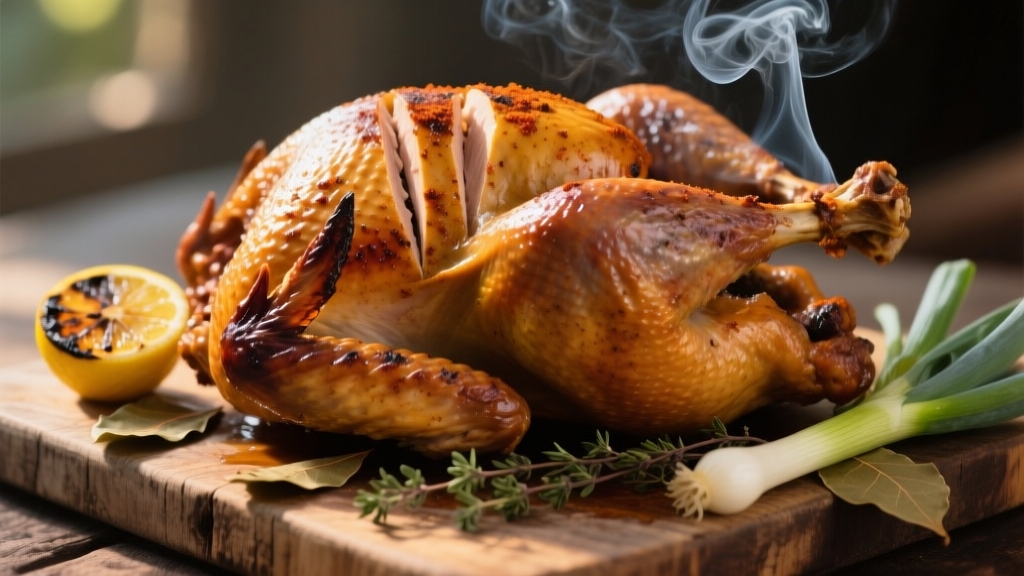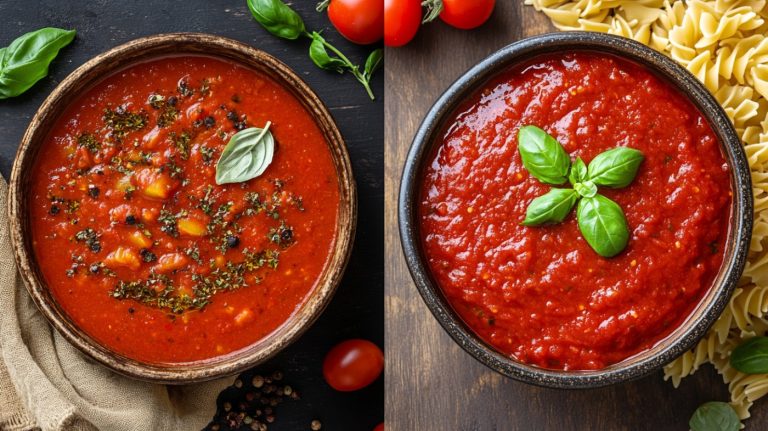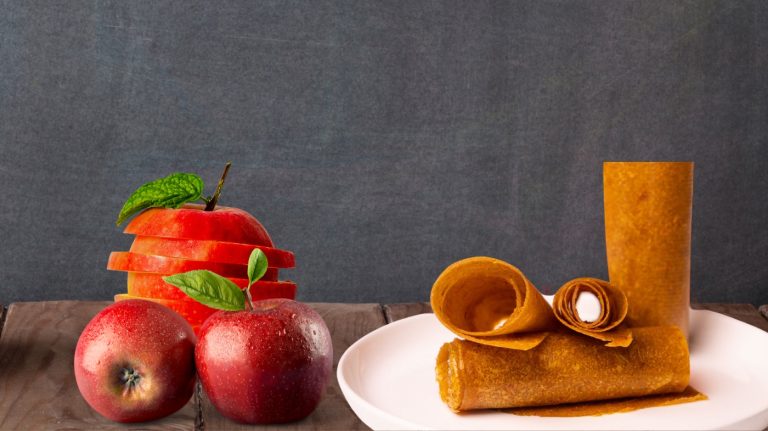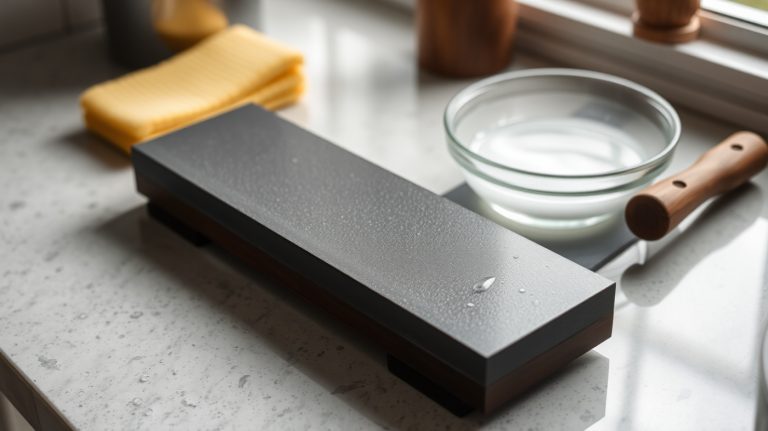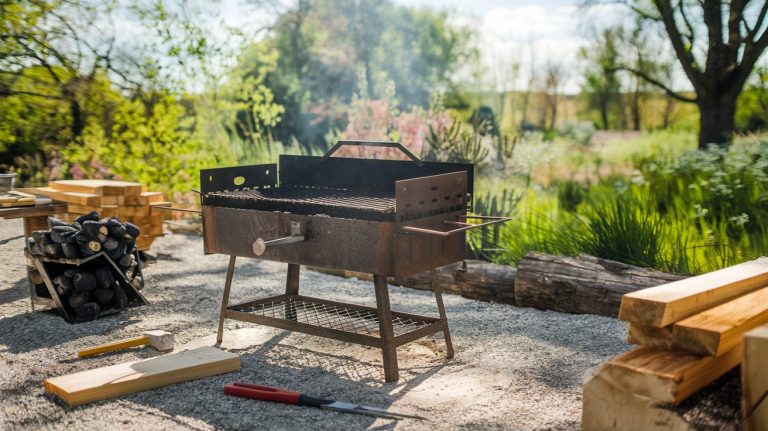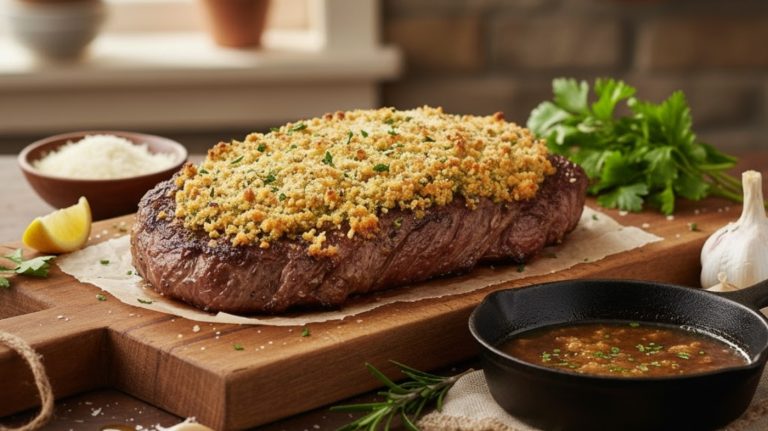Cajun Smoked Turkey Recipe: Juicy, Spicy and Smoky
Choose a heritage turkey for rich flavor, then brine it in a spicy mix of kosher salt, brown sugar, lemon juice, smoked paprika, cayenne, garlic, and herbs. Inject a buttery Cajun seasoning blend into the meat for extra moisture and depth.
Smoke the bird low and slow around 250°F using woods like hickory or apple to infuse smoky notes. Rest before carving to keep juices locked in. Keep going to master each step for a perfect Cajun smoked turkey.
Key Takeaways
- Select a heritage breed turkey for richer flavor and moist, tender smoked meat.
- Brine the turkey 1 hour per pound in a Cajun brine with salt, brown sugar, lemon, and spices.
- Inject melted butter mixed with Cajun seasoning, garlic, and lemon juice evenly into the turkey.
- Smoke at 250°F-275°F using woods like pecan or hickory, maintaining steady heat until internal temp reaches 165°F.
- Rest the turkey 15-20 minutes after smoking to redistribute juices before carving and serving.
Step-by-Step Cajun Turkey Preparation and Smoking Guide at a Glance
| Ingredients / Tools | Steps / Actions |
|---|---|
| 1 whole heritage turkey (12–16 lbs) | Select a heritage breed like Bourbon Red or Narragansett for richer flavor and texture. |
| Kosher salt (1 cup) | Dissolve in boiling water to create the brine base. |
| Brown sugar (½ cup) | Add to brine for sweetness and balance. |
| Lemon juice (¼ cup) | Stir into the brine for tang and freshness. |
| Smoked paprika (2 tbsp) | Adds smoky depth to both brine and rub. |
| Cayenne pepper (1 tsp) | Adjust to taste for desired heat level. |
| Garlic powder (1 tbsp) | Adds savory richness to seasoning and injection. |
| Dried thyme & oregano (1 tsp each) | Infuse the brine with earthy herbal notes. |
| Unsalted butter (½ cup) | Melt and combine with Cajun spices for injection mix. |
| Chicken broth (12 oz) | Blend with butter for moisture and flavor. |
| Cajun seasoning (3 tbsp) | Use for brine, rub, and injection to tie flavors together. |
| Lemon juice (1 tbsp) | Adds brightness to the butter injection. |
| Injection syringe | Use to inject Cajun butter mixture into turkey evenly. |
| Smoker (charcoal or electric) | Preheat to 250°F–275°F and maintain steady heat. |
| Pecan, hickory, or apple wood chunks | Choose wood type to control smoke intensity and aroma. |
| Digital thermometer | Check that internal temp reaches 165°F in the breast. |
| Basting brush or sprayer | Apply seasoned butter every 45–60 minutes for crisp skin. |
| Aluminum foil | Loosely cover while resting 15–20 minutes post-smoking. |
| Sharp carving knife & board | Slice cleanly after resting to keep juices intact. |
Selecting the Perfect Turkey for Smoking
When selecting the perfect turkey for smoking, you should prioritize heritage breeds like Bourbon Red, Midget White, or Narragansett. These turkeys develop richer flavors and firmer textures due to their slower growth and active lifestyles. Choosing the right tools, such as a sharp knife with an ergonomic handle, can make the preparation process more efficient and enjoyable.
These turkeys have more dark meat and extra fat layers, which enhance moistness and deepen flavor during smoking.
More dark meat and added fat layers boost moistness and enrich the flavor in smoked turkeys.
Heritage breeds mature over 26–28 weeks, offering a manageable size that fits most smokers without sacrificing quality.
Unlike commercial breeds that grow rapidly and yield less flavorful meat, heritage turkeys provide superior tenderness and aroma. Their natural diet and free-range habits produce juicy, robust meat ideal for smoking.
Choose birds raised in healthy, free-range conditions to maximize taste and texture in your Cajun smoked turkey. Additionally, breeds like the Bourbon Red are known for being disease-resistant, making them easier to manage on small homesteads.
Preparing the Cajun Seasoning Blend
Let’s kick things off by collecting some key Cajun spices. You’ll want paprika, cayenne, garlic powder, and black pepper as your foundation. These spices are crucial for creating that bold and balanced flavor we all love. Using fresh spices whenever possible will enhance the overall taste and aroma of your blend, much like the importance of regular maintenance in sharpening knives.
Now, when it comes to heat, take it easy! You can adjust it based on your personal preference. It’s all about finding that sweet spot between spicy and savory elements to create a really complex flavor profile. The blend typically includes salt to balance the flavor, not just for seasoning but to enhance other spices effectively flavor balance.
And hey, if you can get your hands on fresh herbs, definitely go for it! They’ll add a nice brightness to your seasoning. But don’t worry if you have to stick with dried herbs; they still do a great job of adding earthy depth to your mix.
Essential Cajun Spices
Although creating an authentic Cajun seasoning blend might seem complex, you can easily combine a few key spices to capture its bold, zesty flavor.
Start with smoked paprika for smoky depth, garlic and onion powders for savory richness, and ground black pepper for piquancy. These spices can be stored easily in modern refrigerators with advanced food management to maintain freshness longer.
Add dried oregano and thyme to bring earthy, herbal notes essential to Cajun blends. Include cayenne pepper to add heat; adjust or omit it based on your preference. Mix these measured spices thoroughly, ensuring even distribution. Use a spice grinder for freshness and uniform texture.
Cajun seasoning represents the flavors of Cajun cuisine, known for its bold and savory profiles, making it perfect for enhancing smoked turkey. Store your blend in an airtight container to preserve flavor. Leaving salt out of the mix lets you control seasoning during cooking, enhancing your Cajun smoked turkey with balanced, robust, and authentic flavors.
Balancing Heat and Flavor
Crafting a balanced Cajun seasoning blend demands careful control of heat to complement, not overpower, the other flavors. Start by moderating cayenne pepper with milder spices like smoked paprika to add smoky depth without excessive burn.
Layer different pepper varieties, black, white, and Sichuan, to distribute heat evenly across your palate, avoiding sharp spikes.
Incorporate savory garlic and onion powders for a rich base, then brighten the blend with a touch of citrus zest to balance heat intensity. Keep salt moderate to preserve flavor clarity and prevent masking heat.
For best results, freshly grind your spices to retain volatile oils and freshness, ensuring a clean, complex heat profile. Adjust cayenne or hot peppers to suit your preferred spice level, creating a multi-dimensional seasoning that enhances your smoked turkey perfectly.
Including herbs such as oregano and thyme can add a subtle herbal lift, enhancing the overall complexity of the seasoning blend herbal brightness. Using durable ceramic bowls for marinating or seasoning prep can help maintain flavor integrity without absorbing odors.
Fresh vs Dried Herbs
Balancing heat with flavorful spices sets the stage, but choosing between fresh and dried herbs shapes the character of your Cajun seasoning blend.
Dried herbs like oregano, thyme, and rosemary work best here. They intensify during slow smoking, offering steady, robust flavor. Since these robust herbs retain flavor longer during simmering and smoking, they are ideal for slow-cooked dishes like this. Their non-porous surfaces also help maintain flavor integrity throughout the cooking process.
Fresh herbs, such as parsley or cilantro, lose vibrancy when dried and are better reserved for garnishing after cooking. When substituting, remember dried herbs are more concentrated; use one-third the amount by volume compared to fresh.
Add dried herbs early to infuse their punch over time, while fresh herbs added late preserve brightness and aroma. Store dried herbs properly to maintain potency months longer, making them ideal for your seasoning mix. This balance ensures your Cajun smoked turkey bursts with deep, layered herbaceous notes.
Crafting the Butter-Based Injection
When you prepare the butter-based injection, start by melting unsalted butter and blending it with your choice of liquids such as chicken broth, or olive oil to create a smooth, emulsified base.
Use about ¼ to ½ cup of butter combined with 12 to 14 ounces of liquid for ideal moisture and flavor balance. Add garlic and onion powders, Cajun seasoning, hot sauce, and a touch of lemon juice for brightness. Blend or whisk thoroughly until the mixture is fully emulsified and silky. Strain the injection through a fine mesh if you want a smoother texture.
Let it cool slightly before injecting; it can be used warm if you’re smoking immediately. Shake well before each use to maintain consistency and ensure even flavor throughout your turkey.
For best results, use room temperature to prevent coagulation of the melted butter during blending. Proper temperature control is crucial, as temperature regulation helps maintain the texture and flavor of your injection mixture.
Making the Cajun Brine Solution
Although the brine requires some preparation, you’ll find it straightforward to combine its key ingredients: water, salt, sugar, and lemon juice. This creates a flavorful Cajun base that tenderizes and seasons your turkey thoroughly.
Start by dissolving kosher salt and brown sugar in a quart or more of boiling water. Once dissolved, remove from heat and stir in fresh lemon juice and optional Creole mustard for tang. Proper temperature control during this step is crucial to avoid spoilage and maintain food safety through moisture removal.
Add smoked paprika, cayenne, minced garlic, onion powder, and black pepper to build depth. Incorporate fresh or dried herbs like thyme, oregano, rosemary, and sage, plus bay leaves and whole peppercorns for aroma.
Allow the mixture to cool completely before use, diluting with cold water to guarantee a safe brining temperature. Use a non-reactive container large enough to submerge your turkey fully. The brine mixture is boiled until salt and sugar dissolve, then cooled to room temperature to ensure proper seasoning and safety.
Brining and Injecting the Turkey
Once your Cajun brine has cooled and is ready, you’ll submerge the turkey fully to guarantee the flavors penetrate evenly. Brine for about 1 hour per pound, turning larger birds once. After brining, rinse lightly, pat dry, and refrigerate uncovered for 8-12 hours to dry the skin.
Next, prepare your injection mix: melted butter combined with Cajun seasoning and garlic works well. Warm slightly for smooth injection. Inject 2-2.5 cups evenly into breasts, thighs, legs, and wing dummies, inserting the needle deep and withdrawing slowly to distribute moisture.
For precise temperature control during cooking, consider using a sous vide cooker with temperature range and precision control to ensure even cooking and perfect results.
| Step | Key Tips |
|---|---|
| Brining Duration | 12-24 hours, 1 hr per pound |
| Submersion | Fully submerged, turn larger turkeys |
| Injection Volume | 2-2.5 cups |
| Injection Sites | Multiple per muscle group |
Setting Up Your Smoker and Wood Choice
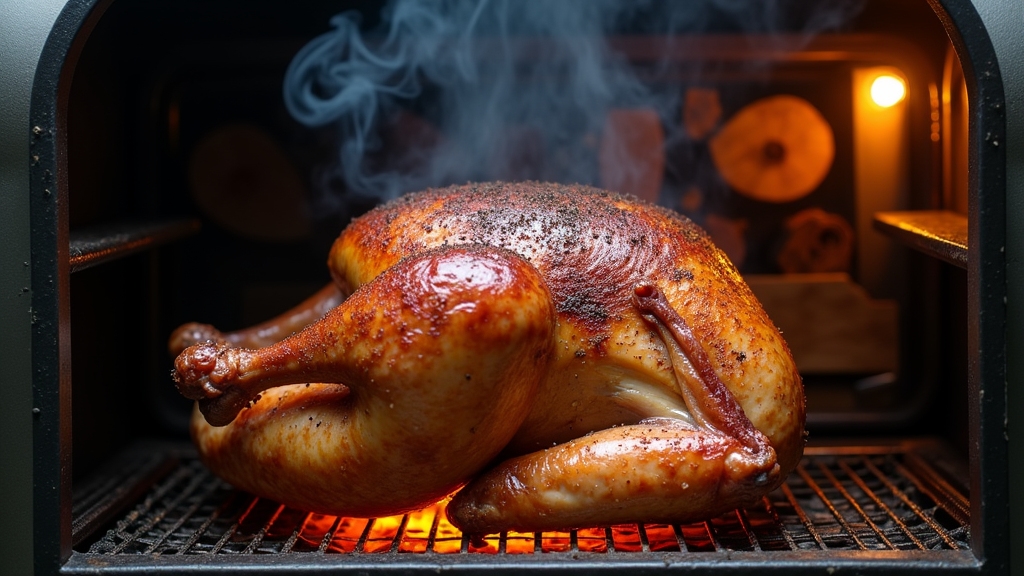
To achieve perfectly smoked Cajun turkey, you’ll need to carefully prepare your smoker and select the right wood. Preheat your smoker to 250°F-275°F and arrange the turkey for indirect heat to ensure even cooking. Use a drip pan underneath to catch drippings, preserving moisture and enhancing flavor. Stabilize the temperature before adding the turkey to maintain consistent heat.
Choose wood that complements Cajun spices:
- Pecan for mild, sweet, nutty smoke
- Hickory for robust, deep smoky flavor (use sparingly)
- Oak for balanced, traditional poultry smoke
- Fruit woods like apple or cherry for subtle sweetness
Add wood chunks away from direct flames and replenish as needed to keep smoke steady without overpowering the bird. For the best results, use a charcoal smoker like the Weber Smokey Mountain Cooker to maintain steady heat and infuse rich smoke flavor.
Smoking the Turkey to Perfection
To smoke your turkey just right, it’s important to keep that smoker steady between 225°F and 375°F. This range helps control how quickly it cooks and the intensity of the smoke flavor. Using a thermometer ensures you can monitor internal heat accurately for the best results.
And hey, don’t forget to use an instant-read thermometer! You’ll want to keep an eye on the breast’s internal temperature, aiming for a final 165°F. This not only ensures it’s safe to eat but also keeps it juicy.
Now, if you’re after that deliciously crispy skin, here’s a little tip: baste regularly with some seasoned butter. It really makes a difference! You can also inject the turkey with a Cajun butter mixture to add richness and moisture throughout the meat.
Also, try to maintain that consistent heat. The goal is to keep everything nice and moist without drying out the bird. Happy smoking.
Ideal Smoking Temperature
Although smoking temperature varies depending on your desired flavor and texture, maintaining your smoker between 250°F and 325°F guarantees the best results for a Cajun smoked turkey.
Smoking at 250°F maximizes smoke absorption and juiciness but takes longer. Meanwhile, 300°F to 325°F speeds cooking and crisps skin. Wearing waterproof shoes can help maintain safety in the kitchen while handling hot equipment. You can start low, then finish high for the best of both worlds.
To control temperature effectively:
- Preheat smoker thoroughly to stabilize heat.
- Use pecan or hickory wood chunks for authentic Cajun flavor.
- Employ indirect heat to avoid hot spots and uneven cooking.
- Monitor with a separate thermometer for accurate, steady temperature.
After smoking, rest the turkey lightly covered for 15-20 minutes to allow juices to redistribute, enhancing flavor and moisture retention resting period. This range ensures flavorful, moist meat with appealing texture and a balanced smoky taste.
Monitoring Internal Temperature
How do you guarantee your Cajun smoked turkey reaches perfect doneness without drying out? Use a calibrated digital instant-read or wireless probe thermometer to monitor internal temperature accurately.
Insert the probe into the thickest part of the thigh or breast, avoiding bone contact for reliable readings. Many pitmasters pull the turkey at around 160°F, relying on carryover cooking during the 20-30 minute resting period to reach the USDA-recommended 165°F.
If your smoker supports it, leave the probe in place for continuous monitoring. Consider using multiple probes to track both breast and thigh temperatures. This real-time data lets you adjust heat and timing, preventing overcooking.
Smoking at 225-250°F typically takes 30-40 minutes per pound for smaller birds and 35-45 minutes per pound for larger turkeys, so plan your cooking time accordingly.
Achieving Crispy Skin
When you want perfectly crispy skin on your Cajun smoked turkey, preparation is key. Start with a dry brine for 24-48 hours to draw out moisture.
Then let the skin dry uncovered in the fridge overnight. Pat it completely dry before smoking and lightly coat with vegetable spray or butter. Using a dry brine for 48-60 hours instead of a wet brine helps reduce excess moisture and promotes crispier skin.
Maintain your smoker at 250-300°F using indirect heat and mild woods like pecan or cherry. After smoking, finish crisping by broiling briefly or placing skin-side down on a hot grill. Let the turkey rest uncovered to avoid soggy skin.
- Dry brined, chilled turkey with taut, dry skin
- Golden, lightly buttered skin before smoking
- Slow, indirect smoke from fruitwoods
- Final crisp under broiler or hot grill grates
Resting and Carving Techniques
Mastering resting and carving techniques is essential to preserve the smoked turkey’s juiciness and guarantee clean, tender slices.
After smoking, rest your turkey for 10-20 minutes, loosely covered with foil to retain warmth while letting steam escape. This allows juices to redistribute, preventing dryness.
Make certain the internal temperature reaches 160°F in the breast and 175°F in the thigh before resting. Using an internal thermometer ensures accuracy in monitoring these temperatures.
Ensure the breast hits 160°F and thighs 175°F before letting your turkey rest.
Use a sharp carving knife and fork to steady the bird on a grooved cutting board. Start by removing legs and thighs, then slice breast meat along the grain in even strokes.
Letting the turkey rest completely helps fibers relax, resulting in firmer, cleaner cuts. Resting on a heat-safe pan also catches drippings for sauces, enhancing flavor without compromising texture.
Serving Suggestions and Side Pairings
Once you’ve rested and carved your Cajun smoked turkey to perfection, it’s time to contemplate how to serve it in a way that highlights its bold flavors.
Pair the turkey with sides that balance its smoky, spicy profile and add textural contrast. Consider layering slices on buttery biscuits or sandwich bread with Cajun mayo for a flavorful sandwich. Serve alongside creamy mashed potatoes or seasoned rice to mellow the spices. Using a grill with a wood pellet blend like Hickory, Maple, Cherry imparts a distinctive smoky flavor that complements these sides beautifully.
Brighten the plate with fresh, crisp salads or roasted vegetables tossed with garlic and Parmesan. Finish with complementary condiments like Creole mayo or a drizzle of herb butter.
- Honey hot jalapeño cornbread adding sweet heat
- Fresh kale salad with citrus vinaigrette for zesty brightness
- Dirty rice or rice pilaf offering savory depth
- Roasted asparagus with garlic and Parmesan for caramelized notes
Frequently Asked Questions
Can I Use a Frozen Turkey for Cajun Smoking?
You shouldn’t smoke a frozen turkey for Cajun seasoning because it cooks unevenly and risks bacterial growth.
Instead, fully thaw your turkey in the fridge; this can take several days depending on size.
Once thawed, dry it well, brine or inject with Cajun spices, and spatchcock for even cooking.
Use a reliable thermometer to make sure it reaches 165°F inside.
This approach guarantees safety and better flavor penetration.
What Wood Types Best Complement Cajun Flavors?
Did you know that blending wood types can enhance Cajun flavors by up to 30%?
For the best results, choose fruit woods like apple or cherry for mild sweetness and color.
Add pecan or hickory for a nutty, robust depth that complements Cajun spices without overpowering.
Avoid using too much mesquite alone; instead, mix it sparingly with milder woods to balance intensity.
Always use kiln-dried wood for clean smoke.
How Do I Store Leftover Smoked Turkey Safely?
Cool your smoked turkey for 10-15 minutes before storing.
Portion the meat and place it in shallow, airtight containers or wrap tightly with foil or plastic wrap.
Refrigerate leftovers within two hours at below 40°F and consume within 3-5 days.
For longer storage, freeze turkey within three days using freezer-safe bags, removing excess air.
Label packages with dates.
When reheating, thaw in the fridge and avoid multiple reheats to guarantee safety.
Is Spatchcocking Necessary for Even Smoking?
No, spatchcocking isn’t strictly necessary for even smoking, but it greatly helps.
By flattening the turkey, you’ll get more uniform heat distribution and consistent smoke penetration, which reduces uneven cooking. If you smoke a whole bird, some parts may cook faster or slower due to shape and thickness differences.
Spatchcocking guarantees juicier meat and crispier skin by exposing all surfaces evenly. It’s a smart technique for better results, but not mandatory.
Can I Prepare Cajun Smoked Turkey in an Electric Smoker?
Yes, you can prepare Cajun smoked turkey in an electric smoker.
It offers stable temperature control between 250°F and 300°F, perfect for slow smoking.
Use wood chips like pecan or hickory to add authentic smoky flavor.
Apply your Cajun rub, inject marinade if desired, and monitor internal temperatures carefully.
Preheat the smoker, baste periodically, and rest the turkey after cooking to guarantee juicy, flavorful results.
Bring Cajun Flavor to Your Next Feast
As you slice into your Cajun smoked turkey, the rich aroma of spice and smoke fills the air, just like a warm southern evening wrapping around you.
The tender, juicy meat, infused with your carefully crafted seasoning and brine, melts effortlessly. Resting was worth every minute.
Serve with bold sides, and watch how this feast transforms any gathering into a lively celebration. You’ve mastered the art, now savor the smoky, spicy reward.

